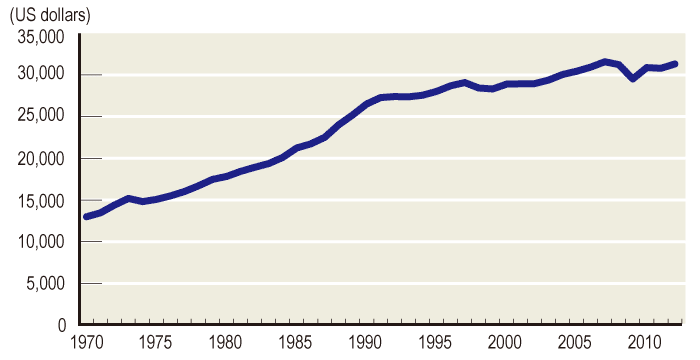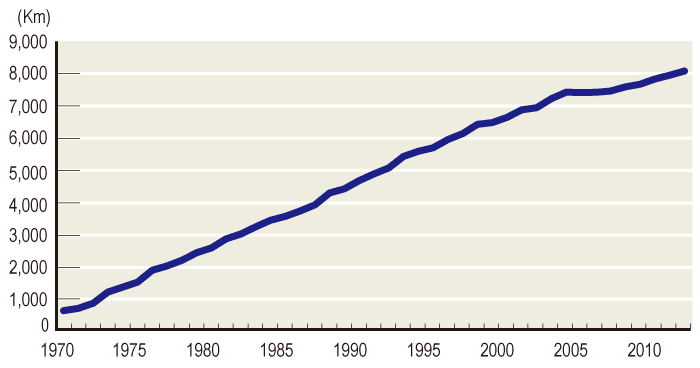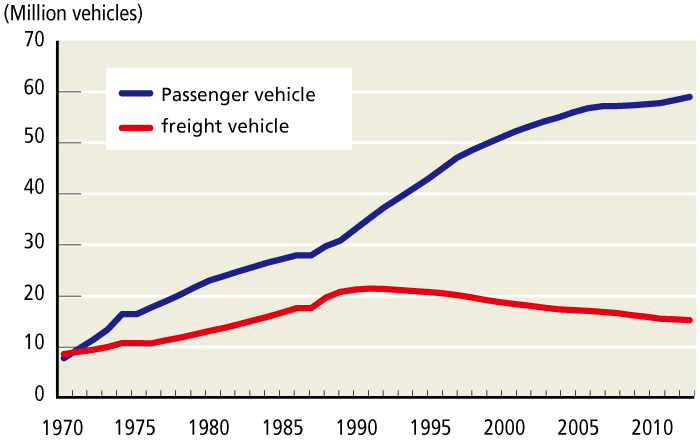History
4. Age of Optimal Maintenance and Management for Maximum Utilization of Existing Roads
By the 21st century, the total length of expressways had
reached more than 10,000km and the public opinion was
that Japan now had sufficient road networks, especially in
urban areas. At the same time, Japan entered an age of
declining birthrates and an aging population (the national
population has been declining since it peaked in 2008).
In addition to these social changes, ever-increasing social
security costs and the fragile national financial condition
brought about the wide-spread belief that public investments
should be economized. As discussed in the previous
section, this led to the abolition of the tax system with
earmarks for roads and the reorganization and privatization
of JH. While road development is slowing down, utilization
of existing road networks and improvement of asset
management is becoming the focus of current programs.
The first task of asset management is to map out strategies
for the aging road infrastructure, which was largely developed
during the high-growth period of the Japanese
economy (from the late 1950s to the 1960s).
The second task is to continually provide road transport
services and to support the lives and economies of the
people who live in a country that is prone to natural disasters
such as earthquakes and typhoons.
The third task is to provide road services that are safe, acces
sible, and environmentally friendly by utilizing evolving ITS
technologies and by improving the quality of roads.
Change in real GDP per capita

Change in total length of expressways

Change in vehicle registrations

1) Strategies for Aging Road Infrastructure
The majority of roads and bridges were constructed in the high-growth period of the Japanese economy and will be 50 years old in the next 10 years. To maintain the safety of this aging infrastructure, periodic investigation and database management, as well as systematic repair work, are required. It is a new technical challenge to efficiently investi gate and repair 5.2 million bridges and 10,000 tunnels. At the same time, this is also a significant challenge in terms of the financial and human resources that are needed to meet road demands.
2) Preparing for Natural Disasters
The Great East Japan Earthquake in March 2011 forced the
reevaluation of the importance of road networks in the face
of large-scale natural disasters. 20% of world-wide
earthquakes with a magnitude of 6 or higher, occur in Japan.
As an earthquake-prone country, disaster prevention
measures, including improvement of bridges’ quake
resistance, have been deemed necessary after the repeated
experience with these disasters. In addition, it is necessary to
enhance road networks to guarantee alternative routes in
the event of road closures after a large-scale disaster and in
order to add disaster prevention functions to existing
roadside service facilities. As climate change is increasingly
occurring on a global scale, Japan has been experiencing
more frequent heavy rains and snows. Landslides on slopes
and snowbound traffic are always significant challenges in a
country with precipitous terrain. Japanese road administra
tion has been implementing countermeasures that include:
constructing slope protection, establishing a snow removal
system, installing road monitoring systems, and improving
operations.
3) Improvement of Road Service Provision using Intelligent Transport System (ITS)
Ring roads are being developed in the Tokyo Metropolitan
Area, where traffic congestion is a serious problem. Once
complete, ring roads are expected to provide more route
options and smoother traffic flow.
Since they were introduced in the 1990s, ITS technologies
have provided various services, including car navigation
systems and Electronic Toll Collection (ETC). Even now, the
technologies are evolving to meet the demands of road
infrastructure and the automobile sectors. Newly introduced
automobiles with crash-avoidance systems offer the poten
tial for fully automatic driving systems sometime in the near
future. In the road infrastructure sector, dynamic traffic
guidance, warning messaging, and vehicular controlling
technologies are being studied as part of road-to-vehicle
and/or vehicle-to-vehicle communication systems.
The advancement of technology is going to integrate road
infrastructure and automobiles into a new synthetic
transport system and will provide a breakthrough solution
for traffic congestion, traffic accidents, and environmental
protection issues, all of which have been major challenges
since the modernization of the road system began.
